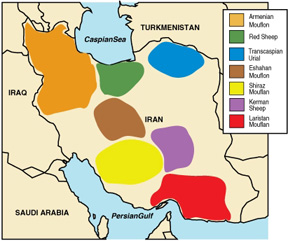 |
Ovis gmelini isphahanica
Muflon de Esfahan (Sp), Esfahan Mufflon (G), Mouflon d'Esfahan (F). Named after the city of Esfahan (or Isfahan) in Iran.
DESCRIPTION In winter, males have a full-length black neck ruff extending to the brisket. There is no bib. Saddle patch, muzzle, chin, throat and lower part of legs are white. The horns appear to be of two types: Those from the Mooteh Wildlife Reserve, about 80 miles (130 km) northeast of Esfahan, are supracervical or perverted, which is to say they curve above and behind the neck as do those of the Armenian mouflon; those from the Tange-Sayad and Kolah-Gazi wildlife refuges, which are within 90 miles (145 km) southwest and southeast, respectively, of Esfahan are cervical, with the tips growing inward toward the neck. The frontal-orbital horn edge is rounded, the frontal-nuchal edge is sharp. Females are similar in appearance to Armenian mouflon females. Some have very small horns, but most appear to be hornless.
DISTRIBUTION & TAXONOMIC NOTES The Esfahan mouflon is found only in Iran, in the mountains near Esfahan. Valdez restricts it to sheep with cervical horns that inhabit the Tange-Sayad and Kolah-Gazi wildlife refuges southwest and southeast of Esfahan; however, for record-keeping, we also accept sheep from the Mooteh Reserve as Esfahan mouflons.
In his original 1910 description of this race, Nasonov misspelled the subspecific name as isphaganica. He later corrected it to isphahanica, but it remains misspelled in some publications.
|





